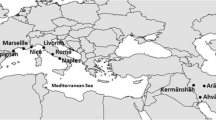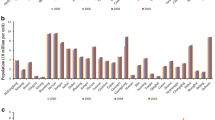Abstract
The risk of cardiovascular and respiratory diseases attributed to satellite-based PM2.5 has been less investigated. In this study, the attributable risk was estimated in an area of Iran. The predicted air PM2.5 using satellite data and a two-stage regression model was used as the predictor of the diseases. The dose-response linkage between the bias-corrected predictor employing a strong statistical approach and the outcomes was evaluated using the distributed lag nonlinear model. We considered two distinct scenarios of PM2.5 for the risk estimation. Alongside the risk, the attributable risk and number were estimated for different levels of PM2.5 by age and gender categories. The cumulative influence of PM2.5 particles on respiratory illnesses was statistically significant at 13–16 µg/m3 relative to the reference value (median), mostly apparent in the middle delays. The cumulative relative risk of 90th and 95th percentiles were 2.03 (CI 95%: 1.28, 3.19) and 2.25 (CI 95%: 1.28, 3.96), respectively. Nearly 600 cases of the diseases were attributable to the non-optimum values of the pollutant during 2017–2022, of which more than 400 cases were attributed to high values range. The predictor’s influence on cardiovascular illnesses was along with uncertainty, indicating that additional research into their relationship is needed. The bias-corrected PM2.5 played an essential role in the prediction of respiratory illnesses, and it may likely be employed as a trigger for a preventative strategy.



Similar content being viewed by others
Data availability
Our data or material may be available from the first or corresponding author upon reasonable request.
Code Availability
The R codes are available under request from the corresponding author.
References
Bland JM, Altman D (1986) Statistical methods for assessing agreement between two methods of clinical measurement. Lancet 327(8476):307–310
Bland JM, Altman DG (2010) Statistical methods for assessing agreement between two methods of clinical measurement. Int J Nurs Stud 47(8):931–936
Boloorani AD, Kazemi Y, Sadeghi A, Shorabeh SN, Argany MJAE (2020) Identification of dust sources using long term satellite and climatic data: a case study of Tigris and Euphrates basin. 224:117299
Danaei G, Farzadfar F, Kelishadi R, Rashidian A, Rouhani OM, Ahmadnia S, Ahmadvand A, Arabi M, Ardalan A, Arhami MJTL (2019) Iran Transition 393(10184):1984–2005
de Hoogh K, Héritier H, Stafoggia M, Künzli N, Kloog I (2018) Modelling daily PM2. 5 concentrations at high spatio-temporal resolution across Switzerland. Environ Pollut 233:1147–1154
De Oliveira BFA, Ignotti E, Artaxo P, do Nascimento Saldiva PH, Junger WL, Hacon SJEH (2012) Risk assessment of PM2. 5 to child residents in Brazilian Amazon region with biofuel production. 11(1):1–11
Denton M, Prus S (2004) V. J. S. s. Walters and medicine Gender differences in health: a Canadian study of the psychosocial, structural and behavioural determinants of health. 58(12): 2585–2600
Dominici F, Peng RD, Bell ML, Pham L, McDermott A, Zeger SL and J. M. J J Samet (2006) Fine Part air Pollution Hosp Admission Cardiovasc Respiratory Dis 295(10): 1127–1134
Farajzadeh M, Gheshlagh RG, Sayehmiri K (2017) Health related quality of life in Iranian elderly citizens: a systematic review and meta-analysis. Int J Community Based Nurs Midwifery 5(2):100
Faridi S, Bayat R, Cohen AJ, Sharafkhani E, Brook JR, Niazi S, Shamsipour M, Amini H, Naddafi K and M. S. J. S. r. Hassanvand (2022). Health burden and economic loss attributable to ambient PM2. 5 in Iran based on the ground and satellite data. 12(1): 14386
Fathollahi L, Wu F, Maleki R, Pongracic B (2023) PM 2.5 concentrations estimation using machine learning methods with combination of MAIAC-MODIS AOD product-a case study in western Iran. Air Qual Atmos Health 16(8):1529–1541
Feng S, Gao D, Liao F, Zhou F, Wang X (2016) The health effects of ambient PM2. 5 and potential mechanisms. Ecotoxicol Environ Saf 128:67–74
Garrigues S, Chimot J, Ades M, Inness A, Flemming J, Kipling Z, Laszlo I, Benedetti A, Ribas R, Jafariserajehlou S (2022) Monitoring multiple satellite aerosol optical depth (AOD) products within the Copernicus Atmosphere Monitoring Service (CAMS) data assimilation system. Atmos Chem Phys 22(22):14657–14692
Ghobakhloo S, Khoshakhlagh AH, Mostafaii GR, Chuang K-J, Gruszecka-Kosowska A (2023) and P. J. F. i. P. H. Hosseinnia Critical air pollutant assessments and health effects attributed to PM2. 5 during and after COVID-19 lockdowns in Iran: application of AirQ + models. 11: 1120694
Hadei M, Shahsavani A, Krzyzanowski M, Querol X, Stafoggia M, Nazari SSH, Jafari AJ, Yarahmadi M, Kermani M, Khosravi (2020) Burden of mortality attributed to PM2. 5 exposure in cities of Iran; contribution of short-term pollution peaks. 224:117365
Hampel R, Schneider A, Brüske I, Zareba W, Cyrys J, Rückerl R, Breitner S, Korb H, Sunyer J (2010) and H.-E. J. E. h. p. Wichmann Altered cardiac repolarization in association with air pollution and air temperature among myocardial infarction survivors. 118(12): 1755–1761
Hsu A, de Sherbinin A, Shi H (2012) Seeking truth from facts: the challenge of environmental indicator development in China. Environ Dev 3:39–51
Khomenko S, Cirach M, Pereira-Barboza E, Mueller N, Barrera-Gómez J, Rojas-Rueda D, de Hoogh K, Hoek G (2021) and M. J. T. L. P. H. Nieuwenhuijsen Health impacts of the new WHO air quality guidelines in European cities. 5(11): e764
Krishna B, Mandal S, Madhipatla K, Reddy KS, Prabhakaran D, Schwartz JD (2021) Daily nonaccidental mortality associated with short-term PM2. 5 exposures in Delhi, India. 5(4)
Li G, Aboubakri O, Soleimani S, Maleki A, Rezaee R, Safari M, Goudarzi G, Fatehi F (2024) Estimation of PM2. 5 using high-resolution satellite data and its mortality risk in an area of Iran. Int J Environ Health Res: 1–13
Lim SS, Vos T, Flaxman AD, Danaei G, Shibuya K, Adair-Rohani H, AlMazroa MA, Amann M, Anderson HR, Andrews KG (2012) A comparative risk assessment of burden of disease and injury attributable to 67 risk factors and risk factor clusters in 21 regions, 1990–2010: a systematic analysis for the global burden of Disease Study 2010. Lancet 380(9859):2224–2260
Maciejewska KJAQ, Atmosphere and Health (2020) Short-term impact of PM2. 5, PM10, and PMc on mortality and morbidity in the agglomeration of Warsaw. Poland 13(6):659–672
Moridnejad A, Karimi N, Ariya PA (2015) A new inventory for middle east dust source points. Environ Monit Assess 187:1–11
Nordio F, Kloog I, Coull BA, Chudnovsky A, Grillo P, Bertazzi PA, Baccarelli AA, Schwartz J (2013) Estimating spatio-temporal resolved PM10 aerosol mass concentrations using MODIS satellite data and land use regression over Lombardy. Italy Atmospheric Environ 74:227–236
Organization WH (2014) Million premature deaths annually linked to air pollution. World Health Organization, Geneva, Switzerland
Organization WH (2021) WHO global air quality guidelines: particulate matter (PM2. 5 and PM10), ozone, nitrogen dioxide, sulfur dioxide and carbon monoxide. World Health Organization
Page MJ, McKenzie JE, Bossuyt PM, Boutron I, Hoffmann TC, Mulrow CD, Shamseer L, Tetzlaff JM, Akl EA (2021) and S. E. J. I. j. o. s. Brennan The PRISMA 2020 statement: an updated guideline for reporting systematic reviews. 88: 105906
Pirsaheb M, Zinatizadeh A, Khosravi T, Atafar Z, Dezfulinezhad S (2014) Natural Airborne Dust and Heavy metals: a Case Study for Kermanshah. Western Iran (2005–2011)
Sachindra D, Huang F, Barton A, Perera B (2014) Statistical downscaling of general circulation model outputs to precipitation—part 2: bias-correction and future projections. Int J Climatol 34(11):3282–3303
Scarselli A, Corfiati M, Di Marzio D, Marinaccio A, Iavicoli SJ (2018) Gender differences in occupational exposure to carcinogens among Italian workers. 18: 1–10
Sekhavati E, Jalilzadeh Yengejeh R (2021) Investigation and optimization of air pollution risk by a multi-criteria decision making method using fuzzy TOPSIS: a case study of construction workers. J Adv Environ Health Res 9(4):265–276
Shahsavani A, Tobías A, Querol X, Stafoggia M, Abdolshahnejad M, Mayvaneh F, Guo Y, Hadei M, Hashemi SS (2020) Short-term effects of particulate matter during desert and non-desert dust days on mortality in Iran. J E i Khosravi 134:105299
Shamsipour M, Hassanvand MS, Gohari K, Yunesian M, Fotouhi A, Naddafi K, Sheidaei A, Faridi S, Akhlaghi AA, Rabiei (2019) National and sub-national exposure to ambient fine particulate matter (PM2. 5) and its attributable burden of disease in Iran from 1990 to 2016. 255:113173
Stafoggia M, Schwartz J, Badaloni C, Bellander T, Alessandrini E, Cattani G, De’Donato F, Gaeta A, Leone G, Lyapustin A (2017) Estimation of daily PM10 concentrations in Italy (2006–2012) using finely resolved satellite data, land use variables and meteorology. Environ Int 99:234–244
Vallius M (2005) Characteristics and sources of fine particulate matter in urban air
Vodonos A, Friger M, Katra I, Krasnov H, Zahger D, Schwartz J, Novack V (2015) Individual effect modifiers of dust exposure effect on cardiovascular morbidity. PLoS ONE 10(9):e0137714
Wang Q, Wang J, He MZ, Kinney PL, Li i T.J.E. (2018) A county-level estimate of PM2.5 related chronic mortality risk in China based on multi-model exposure data. 110:105–112
WHO (2021) Retrieved September 18, 2023, from https://www.who.int/news-room/feature-stories/detail/what-are-the-who-air-quality-guidelines
Zanobetti A, Schwartz J, Samoli E, Gryparis A, Touloumi G, Atkinson R, Le Tertre A, Bobros J, Celko M, Goren A (2002) The temporal pattern of mortality responses to air pollution: a multicity assessment of mortality displacement. Epidemiology: 87–93
Zanobetti A, Franklin M, Koutrakis P, Schwartz JJEH (2009) Fine particulate air pollution and its components in association with cause-specific emergency admissions. 8(1):1–12
Zhang S, Breitner S, Cascio WE, Devlin RB, Neas LM, Diaz-Sanchez D, Kraus WE, Schwartz J, Hauser ER (2018) A. J. P. Peters and f. toxicology Short-term effects of fine particulate matter and ozone on the cardiac conduction system in patients undergoing cardiac catheterization. 15(1): 1–9
Acknowledgements
We thank the National Department of Environment and Iran Meteorological Organization for providing us with the data. This research was supported by the Environmental Health Research Center, Kurdistan University of Medical Sciences (IR.MUK.REC.1402/201). The authors would like to thank the Kurdistan University of Medical Sciences for its support.
Funding
This work was supported by the Environmental Health Research Center, Deputy of Research and Technology at Kurdistan University of Medical Sciences with grant number of IR.MUK.REC.1402.201.
Author information
Authors and Affiliations
Corresponding authors
Ethics declarations
Consent for publication
Not applicable.
Competing interests
The authors declare that they have no known competing financial interests or personal relationships that could have appeared to influence the work reported in this paper.
Ethics approval
This study was approved by the ethics committee of the Kurdistan University of Medical Sciences.
Consent to participate
The study did not investigate human subjects and the data with no personal identity was obtained from the health deputy.
Additional information
Publisher’s Note
Springer Nature remains neutral with regard to jurisdictional claims in published maps and institutional affiliations.
Electronic supplementary material
Below is the link to the electronic supplementary material.
Rights and permissions
Springer Nature or its licensor (e.g. a society or other partner) holds exclusive rights to this article under a publishing agreement with the author(s) or other rightsholder(s); author self-archiving of the accepted manuscript version of this article is solely governed by the terms of such publishing agreement and applicable law.
About this article
Cite this article
Rahmati, S., Aboubakri, O., Maleki, A. et al. Risk of cardiovascular and respiratory diseases attributed to satellite-based PM2.5 over 2017–2022 in Sanandaj, an area of Iran. Int J Biometeorol (2024). https://doi.org/10.1007/s00484-024-02697-3
Received:
Revised:
Accepted:
Published:
DOI: https://doi.org/10.1007/s00484-024-02697-3




